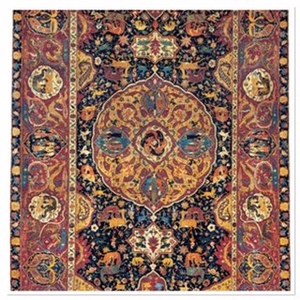It was first exhibited in 1904 at St. Petersburg. It was rediscovered by Arthur Upham Pope and shown again in 1931 in London, at the International Exhibition (Congress) of Persian Art, where it caused a great sensation. For the next twenty-three years, Pope had it on loan exhibition" and it became known as the Sanguszko carpet due to its provenance. The carpet was displayed in 1949 for the visit of the Shah of Iran to Pope's Asia Institute in New York. In 1951 Pope saw a picture of the jinbaori war vest of Toyotomi Hideyoshi (1536-1598) that is made from a Kashan flat weave, with the figure of a lion attacking an antelope, and Pope recognized the design as coming from the same cartoon as that used for this carpet."
"This jinbaori vest was made to wear over armor. It was reportedly owned by Regent Toyotomi Hideyoshi and has been preserved through time by Kodai-ji Temple, established in memory of Hideyoshi by his widow, Kita-no-Mandokoro.
This vest was woven of silk using tapestry techniques. The textile may originally have been a carpet made in Kashan in Persia. The design of a lion attacking his prey is a traditional motifs in Persian carpets. Such carpets were imported into Japan by Portuguese ships in the Momoyama Period. Placing textiles on the floor, however, was incongruous with the Japanese life style, so the Japanese rarely used them as carpets.
Toyotomi Hideyoshi, the high-spirited Momoyama-Period military ruler, tried to maintain an atmosphere of luxury even within his military camps by turning exotic textiles such as Persian carpets into jinbaori vests."
Extracts:



